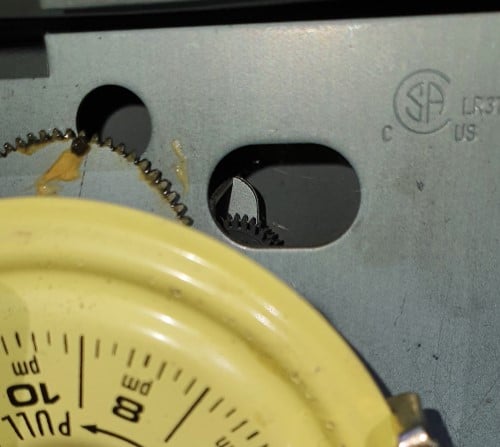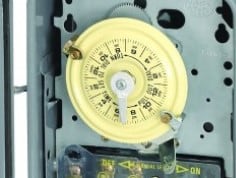This post may contain references or links to products from one or more of our advertisers. We may receive compensation when you click on links to those products. Terms apply to the offers listed on this page. For an explanation of our Advertising Policy, visit this page.
At the heart of every pool is a filter pump that needs to be run every day for a specified length of time. Rather than try to remember to turn a pool pump on and off every day, pool builders and owners have traditionally decided to install timers on their pool pumps to establish some form of autonomy for their pool filtration. I’m occasionally still surprised when I get a call from someone who doesn’t know how to set the pool timer or adjust the clock. It’s a pretty simple process, let me explain how it’s done.
Mechanical clock pool timers have very few functions that you have to worry about. First, check the inspection window to make sure the clock is getting power and is operating. Second, set the clock to the current time. Third, set the on and off trippers for the correct run times.
Intermatic Pool Pump Timer

For many years the Intermatic brand electro-mechanical 24-hour timer clock has been the most available option to control swimming pool single-speed pump operation.
The Intermatic brand actually has a whole line of mechanical and digital controllers for all sorts of applications beyond single-speed pool pumps. Their controllers can operate 2-speed pumps, variable speed pumps, multiple pump systems, as well as accessories and remote controls. And of course, they have applications beyond swimming pools as well. However, the yellow-face mechanical timers have become so commonplace over the years for pool pump controls that it has almost gone the way of Kleenex and Band-Aid where the brand name has replaced the description of the product.
In the context of swimming pool pump operation, and this article, when we talk about Intermatic timers we are talking about the 24-hour mechanical time clock and we often do so interchangeably. Also, for the purposes of this discussion, we are only talking about single-speed controls.
How Does a Pool Pump Timer Work
The reason the Intermatic mechanical timer has lasted so long and continues to be used is the simplicity of its design. Whether the timer in question is for 110v or 220v there is very little that can go wrong. Your basic components are the motor, the clockface(or time dial), the time pointer, the on and off trippers, and the manual override. The only true replacement parts are the motor and the on/off trippers.
As the motor receives voltage it then turns the time dial around the time pointer. As the time dial rotates around the time pointer the on and off trippers are attached to the time dial and “trip” the switch on and off as they pass the time pointer.
As I said, it’s a very simple and eloquent system with very few moving parts. In general, the trippers will wear out with time, and occasionally the motor will burn itself out.
Check The Timer Motor

How do you know if the mechanical motor is working? You might ask. Just to the “2 o’clock side of the clock on every mechanical timer is a small inspection window. Of course, I call it a window when in reality it’s just a hole in the sheet metal housing.
You may need a flashlight, but look through that small opening and you will see 4 gears that are attached to the motor and timer face. If the motor has power and is working you’ll see the gears rotating. The gears rotate fast enough that if you watch them for 2-5 seconds you’ll see definitive movement.
Once you’re positive you have a working motor, you can move on to making sure everything is set to turn on and off automatically.
Setting the Timer
There are 2 main facets to setting the mechanical timer for a pool pump, setting the time, and setting the on/off trippers.

First, you need to set the time, which is good to know in case of a power outage, or daylight savings adjustments. To do this, pull the yellow-faced time dial (clockface) toward you. This will disengage the dial from the gear on the back and you can now rotate the dial. Rotate the dial until the silver time pointer is pointing to the correct time.
Pro-tip: Most of these mechanical clocks are 24-hour clocks so you want to double-check that it is correctly set to AM or PM
It may be tempting to take out a screwdriver and adjust the time pointer to the correct time on the time dial. If you do this, the trippers will not operate at the correct time as they rotate around the pointer. On occasion in the field, I have seen some pool owners make this mistake. Just to be clear, the time pointer should always point straight down to what would be the 6 o’clock position on a standard clock face.
Second, you need to set the on and off trippers. These should be adjusted as needed throughout the season. If the trippers are brand new you’ll need to thread the thumbscrews into the tripper. Once the screw is in the threads, simply place the tripper on the outer edge of the time dial so it points to the appropriate time, and then tighten down the screw until the tripper is secured.
As long as you have power to the timer it will now turn on and off automatically.
How to Manually Operate a Pool Timer
Occasionally a pool pump needs to be operated during times apart from the scheduled run time. Rather than adjust the trippers and wait for the pump to turn on the timer has a manual on/off switch. Newer models often have a red handle, but in either case, there are typically arrows indicating how to operate the switch. Once the timer switch is manually operated, it will need to be manually switched in the opposite direction to cancel out, or you will have to wait until the tripper rolls around, which could be up to 23 hours later
Pro-tip: Install a second ‘off’ tripper and set it to trip the off switch after a few hours after manually switching on the timer. This is very helpful if you are circulating the water for chemical addition, or otherwise ‘quick cleaning’ your pool.
While the world is going more and more in the direction of automation and digital controls, these electro-mechanical timer clocks still have their place and will be in use for as long as there are directly wired pool pumps.
Check out the next article to see where pool algae come from and how to manage it.
Recent Posts
So many of you that own a swimming pool don't know where to start, especially if you're new to pool ownership. Here I have put together a 'greatest hits' checklist for swimming pool maintenance. So...


